LED test / review
EN
Lumileds Luxeon V (CSP, 2017)
L1V1-407003V500000
UPDATE --- 06/23/18 --- raw data added! (link)

In the first days of LED technology, 2003, Lumileds released the Luxeon V LED. For it’s release it was one of the brightest emitter in the world and offered many manufacturers of lighting systems new possibilites in design and luminous power.
Fourteen years later, a new Luxeon V was presented to the public, available in 70 CRI option only. Offered as Chip Scale package (CSP) based emitter and very high efficiency and high power (officially it can powered up to 4,800 mA), it sounds very interesting for directional optics use, like in flashlights.
In this big review I tested two samples of Luxeon V out of different suppliers, one from Led4power and one from Mouser – but same CCT and bin.
All LEDs are purchased in the last four weeks.
Technical data
Claimed by supplier and as stated in official datasheet, Tj 85 °C / If 1,400 mA unless noted otherwise
Order code: L1V1-407003V500000
Type: single die (CSP based, Flip Chip)
Binning: W, typ. 570 - 600 lm (Led4power)
Rated voltage: Class G, min. 2.85 V, max. 3.00 V (Led4power)
Max. forward current: 4,800 mA
Max. peak forward current: 4,800 mA
Viewing angle: typ. 120° (total 150 ° [1])
Thermal resistance: typ. 1.25 °C/W
Junction temp.: max. 150 °C
[1] Total angle at which 90% of total luminous flux is captured.
Mouser doesn't give any further values or specs for voltage / flux bin.
The official datasheet can be found here (offical Lumileds website, pdf)
First appearance
Unless other LEDs the Luxeon V is 4.00 x 4.00 mm in size (commonly referred as ‚4040 size‘). The look is reminiscent of the latest gen Cree LEDs, most of the visible outer surface is yellow-colored, maybe covered with phosphor.
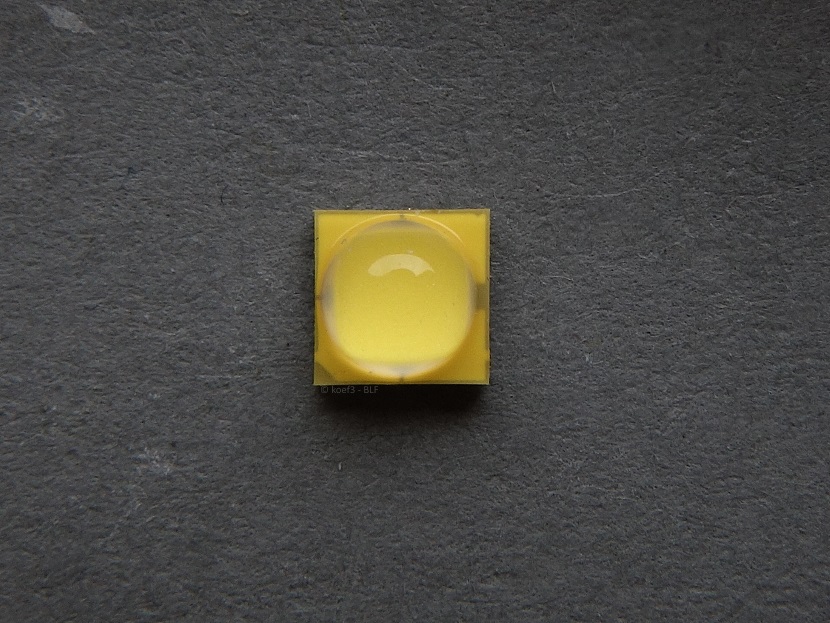

This LED uses a classic silicon dome known from XM-L2 / XP-G2.

The footprint is not the same like XP or XM. Also already known from the Luxeon MZ (test here), the size is between the two, which makes the using of industry standard boards more difficult.

(all values in mm)
On XP boards the LED can fit, but not on all. Noctigon boards work but the use of less solder paste is necessary to avoid it squeezing out and shorten thermal pad and anode/cathode in reflow process.

On XM boards the Luxeon V simply doesn’t fit:
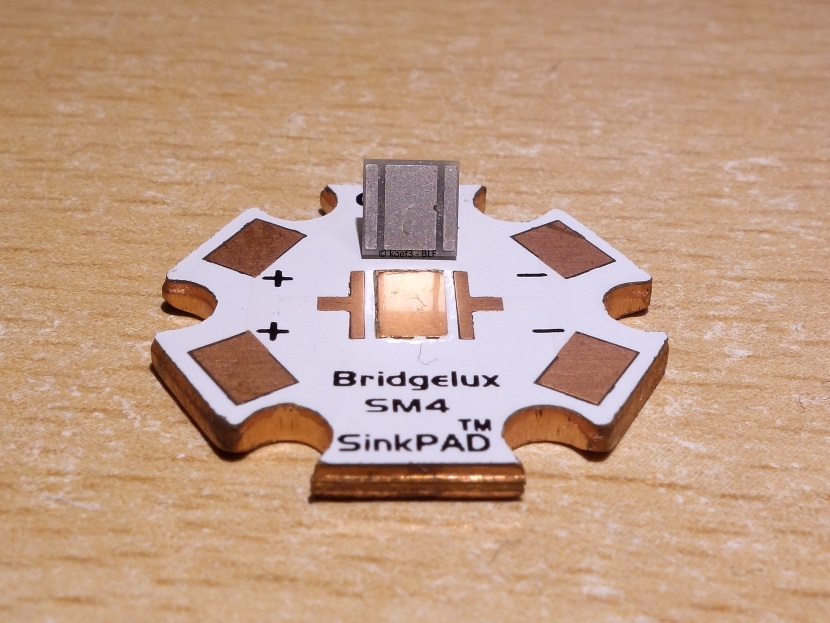
Some weeks ago Led4power introduced direct thermal path (4040) boards, in 16 mm size. For sure this LED fits perfectly on this board.
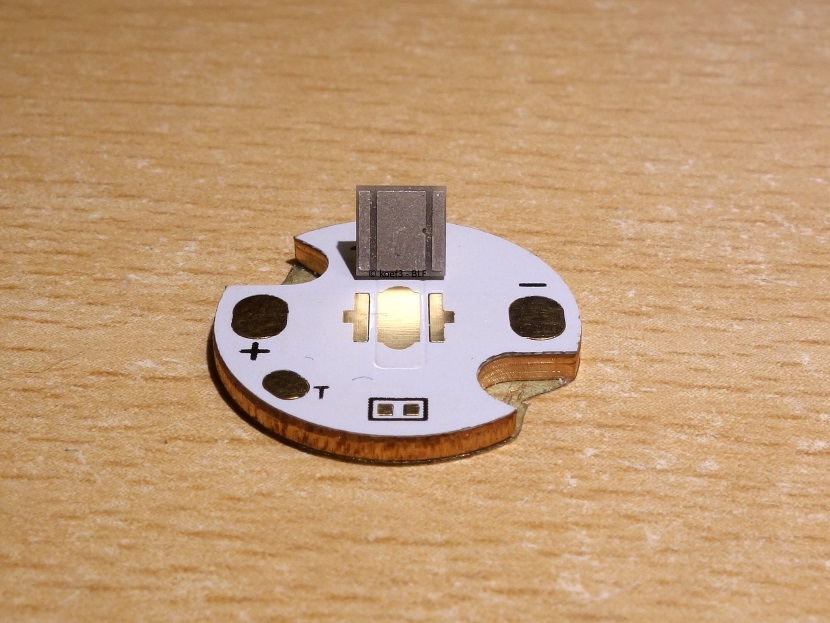
But a test on this board shows hat the gain in luminous flux is negligibly small and cannot even be reliable measured.
LED chip and die
Like the most new LEDs the Luxeon V is built in Flip Chip design. This means that the contacts for anode + cathode lays underneath the LED chip which makes the use of bonding wires known from older LEDs unnecessary. The biggest advantage of this design might be lower production cost and (in most cases) better heat dissipation to the MCPCB.
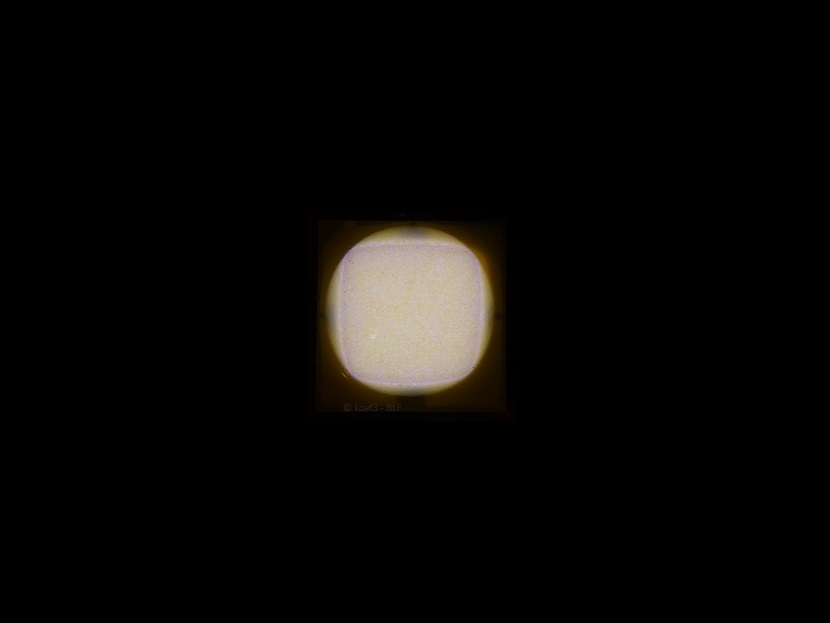

The die on very low current reminds me of the Nichia 219C. The LES is covered with fine yellow-red-blue dots, but lacks big color differences at the edges (unless other LEDs like XP-L2). This might be a good sign for a nice beam pattern in directional optics, but we would see this later.
This LED is marketed as ‚Chip scale package based‘ (quote Lumileds datasheet: ‚LUXEON V is a Chip Scale Package (CSP) based high power emitter‘). The JEDEC defined this in the standard J-STD-012 in which is stated that the package must have an area not greater than 1.2 times of that of the die. A closer look under the phosphor…
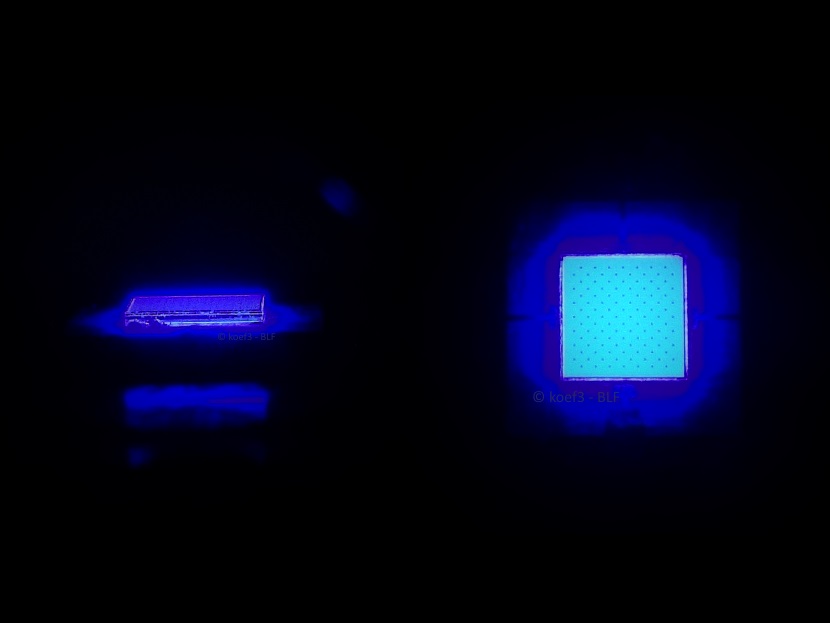
(Mouser sample)
... reveals that the package is much bigger than the die (approx. 3.6 times) and if the complete housing is used for the defintion the name ‚CSP‘ might be wrong for this LED. Perhaps the designation applies only to the LED chip itself, but this can not be mounted on a circuit board directly. Or it’s only valid for the emitter with dome on, but this also didn’t meet the definition given by the JEDEC.
Personally I assume that the name ‚CSP‘ is only meant for the internal design or leveraging key elements of this package design ('CSP based'), especially in the optimized heat dissipation already known from other CSP based emitters like Nichia E21A.
Like other LEDs in Flip Chip design the LED chip emits light to the side too, not only to head-on, which increases the LES significantly and lowers the luminance.
With dome on (original state) the LES is 9.83 mm² (0,01524 sq in) in size.
In shaved (dedomed) state, the LES is 6.43 mm² (0,009967 sq in) in size.
Without phosphor the pure LED chip has a LES of 6.19 mm² (0,009595 sq in).
Performance and overcurrent capabilities
25 °C Tsp, unless noted otherwise, LED mounted on specially adapted XP20 board.
In this graphs one sample of every supplier is shown. I tested ALL five samples, everyone of them has a very small spread in voltage and light flux.
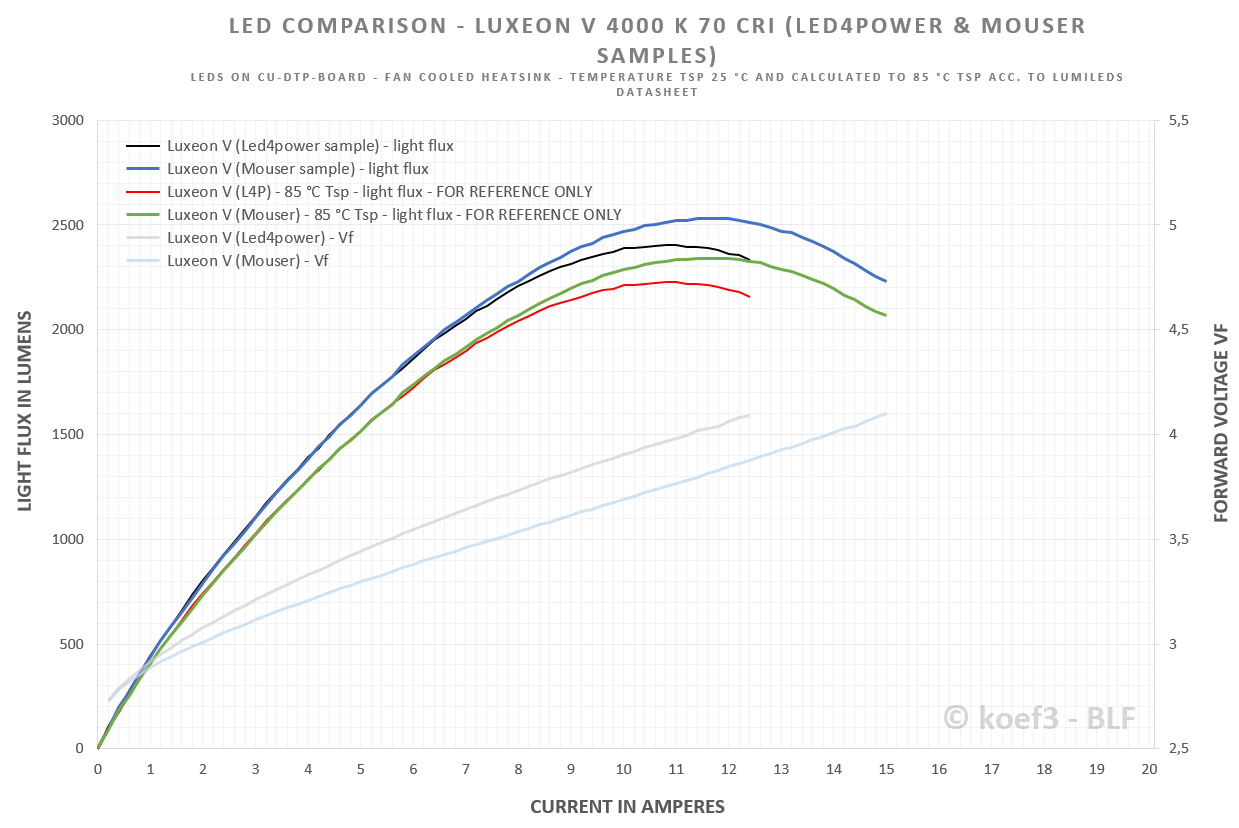

You can find raw data of this test here!
Overall, there are interesting results because the voltage is very different from each other. The Mouser have a much lower Vf at same light flux, and therefore a significantly better efficiency – escpecially at high currents.
Led4power sample
Within official parameters
- At 4,800 mA (max rated / peak current): 1,591 lm @ 3.42 V
- Power at rated maximum: 16.42 W
- Efficiency at 4,800 mA: 96.9 lm/W
- At 1,400 mA (binning current, but 25 °C Tsp): 587.6 lm @ 2.98 V
- At 1,400 mA (binning current, corrected to 85 °C Tsp acc. To Lumileds datasheet): 544 lm
Overcurrent:
- Maximum at 10,600 mA, 2,405 lm @ 3.88 V
- Power at maximum 41.9 W
- Sweet spot at 7,600 mA (2,149 lm @ 3.70 V)
- Power at sweet spot 28.1 W
- Efficiency at max 57.4 lm/W, in sweet spot 76.5 lm/W
I define the sweet spot as the position in the diagram which gives a good average between light flux, current and efficiency. In most cases it lays roughly 15 to 35 percent lower than maximum possible light flux.
Mouser sample
Within official parameters
- At 4,800 mA (max rated / peak current): 1,590 lm @ 3.28 V
- Power at rated maximum: 15.74 W
- Efficiency at 4,800 mA: 101.2 lm/W
- At 1,400 mA (binning current, but 25 °C Tsp): 589.3 lm @ 2.94 V
- At 1,400 mA (binning current, corrected to 85 °C Tsp acc. To Lumileds datasheet): 546 lm
Overcurrent:
- Maximum at 11,600 mA, 2,529 lm @ 3.81 V
- Power at maximum 44.2 W
- Sweet spot at 7,600 mA (2,173 lm @ 3.51 V)
- Power at sweet spot 26.7 W
- Efficiency at max 57.2 lm/W, in sweet spot 81.4 lm/W
Interesting facts
- The spread of the both samples tested here is interesting. The Mouser sample performs a bit better and also reaches a higher current / light flux at much lower Vf. Important to know that the test setup, reflow procedure as well as timing and board was identical and was cross-tested with other Luxeon V samples from same suppliers.
- After the test up to 15 Amps the Luxeon V delivers approx 13 (@ 200 mA) to 3 percent (@ 1,400 mA) lower light flux at also a lower Vf than before. After ten minutes the efficiency and the voltage reaching its original level. I can reproduce this effect, i tested this five times.
- After several minutes on ultra high and high currents (15 to 10 Amps) the phosphor doesn’t look damaged in any way.
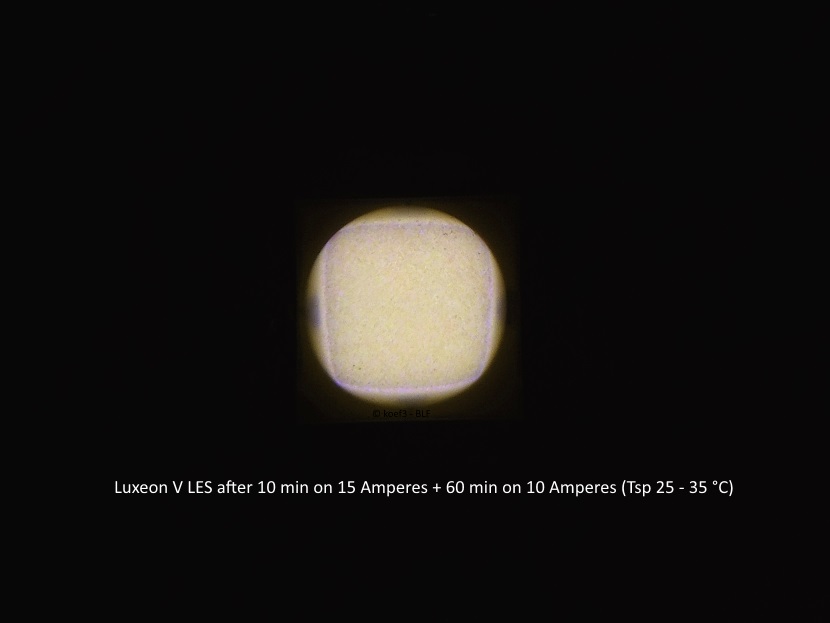
- This LED seems to be much more sensitive in thermal characteristics than other Flip Chip emitters. The same possible maximum power on 4040 16 mm DTP boards and the lower max. Tj (temperature junction) stated in the datasheet is a clear sign that the maximum light flux is reached at much lower junction temperature than of other actual LEDs (XP-L2).
- Above 13 Amps the tint shifts slightly to blue, but much less.
- At 10 Amps at 25 to 85 °C Tsp the Vf drops by about 44 mV which is much better than stated in the datasheet (for same temp. difference approx. 200 mV)
- The SST-40-W is a very efficient LED, it reaches a lot higher light flux even at lower current but cannot deliver highest flux because of the weak bonding wires. It is important to know that the XP-L2 V5 40E (test here) shown in the diagram delivers not the flux bin stated by supplier and datasheet - but it delivers more flux than the V, but at a lot higher Vf.
Luminance
I established a new method for determining luminance, especially to ensure more realistic values for 'real-life' conditions (flashlight use). The measurements are taken with a new original Convoy C8 reflector, but with same heatsink / setup as previously used in flux measurement.
Reflectivity for reflector 85 %
Transmission UCL glass 97,8 %
Values at 25 °C Tsp, for 85 °C Tsp values are 6 to 14 percent lower, depending on LED
LEDs marked with Warning sign uses old values are still taken with previous method (determining die size) due to problematic light distribution (donut holes etc).

Dedoming (I tested only the shaving method) of the V (led4power sample) is absolutely not effective, which really surprises me. The luminance just increases by about 8 percent! In general, this LED is not suitable for thrower and ultra long range distance flashlights!
Light quality and use in optics
I mentioned it earlier: because of the missing abnormal colored areas around the LES the beam is very nice, almost as good as you know it from the old XP-L or XM-L(2). From beam profile with an OP reflector it also looks very similar the XP-L or XM-L2.
In comparison with the XP-L2 (which has a very annoying and visible yellow-colored corona) the difference is obvious.
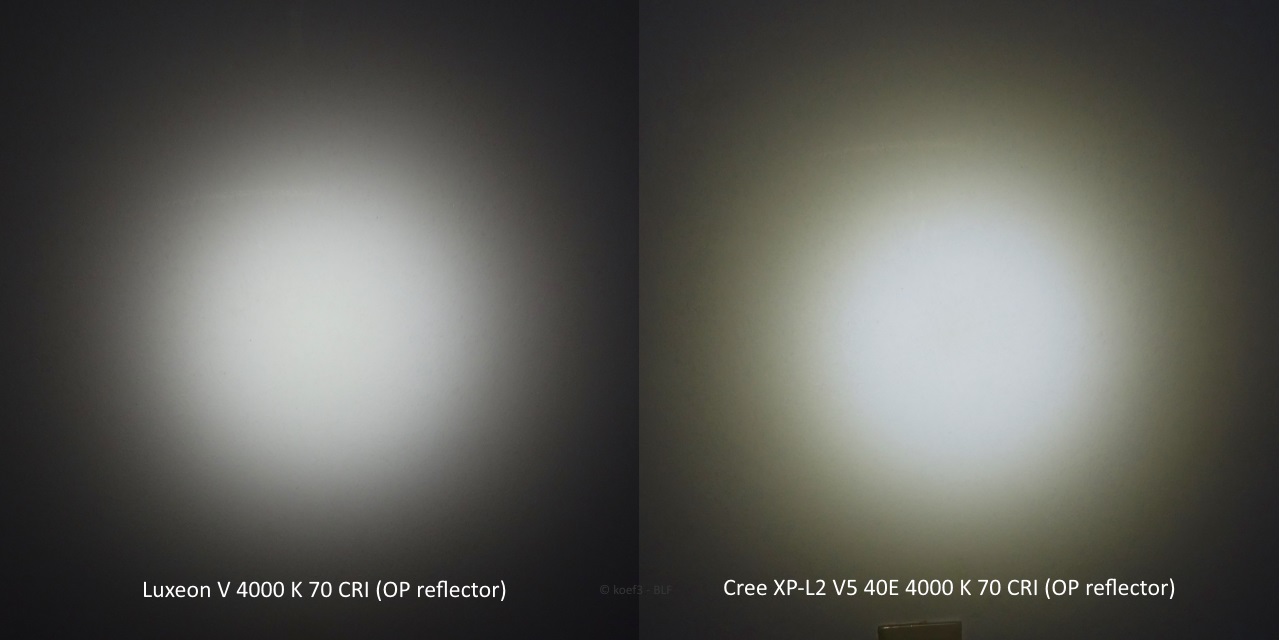
The tint is relatively warm, with no green or red in it. To be honest, a more reddish tint would be nice but the tint is almost completely fine to use it in standard flashlights. After dedoming (shaving) the color was a little bit warmer, maybe at 3800 K or so.
The CRI is low, in direct comparison with a 219C R9050 sm405 the color rendition is not as good, but this should be ok for standard flashlight users.
Conclusion
Overall, this LED is good for flashlight use despite using actual Flip Chip technology. The tint in the beam pattern is consistent and the tint has no green or yellow in it. Also the V delivers a lot of light at high currents, at low Vf (Mouser sample only).
I don’t like the big differences in Vf and heat dissipation, and that the light flux at binning conditions is a little bit lower than stated in the datasheet / supplier.
If you need an actual emitter with a nice (warmer or cold) tint and high power capabilities and the color rendition is negligible, the Luxeon V CSP might be the right choice for you!
Pro
- high flux possible
- low Vf (Mouser sample)
- nice beam pattern even in SMO reflectors
- nice tint
- fair price
Neutral
- unusual footprint, new accessoires (boards / center rings) needed
- called ‚CSP‘ despite not fulfilled definition
- typical light flux at binning current not reached
Contra
- huge spread in Vf and possible maximum current
- luminance low, even in dedomed state
Thanks a lot for reading! 
Greetings, Dominik (aka BLF member koef3)
Mistakes, suggestions or offers / sponsoring of LEDs which I should test next are best sent via PM.
